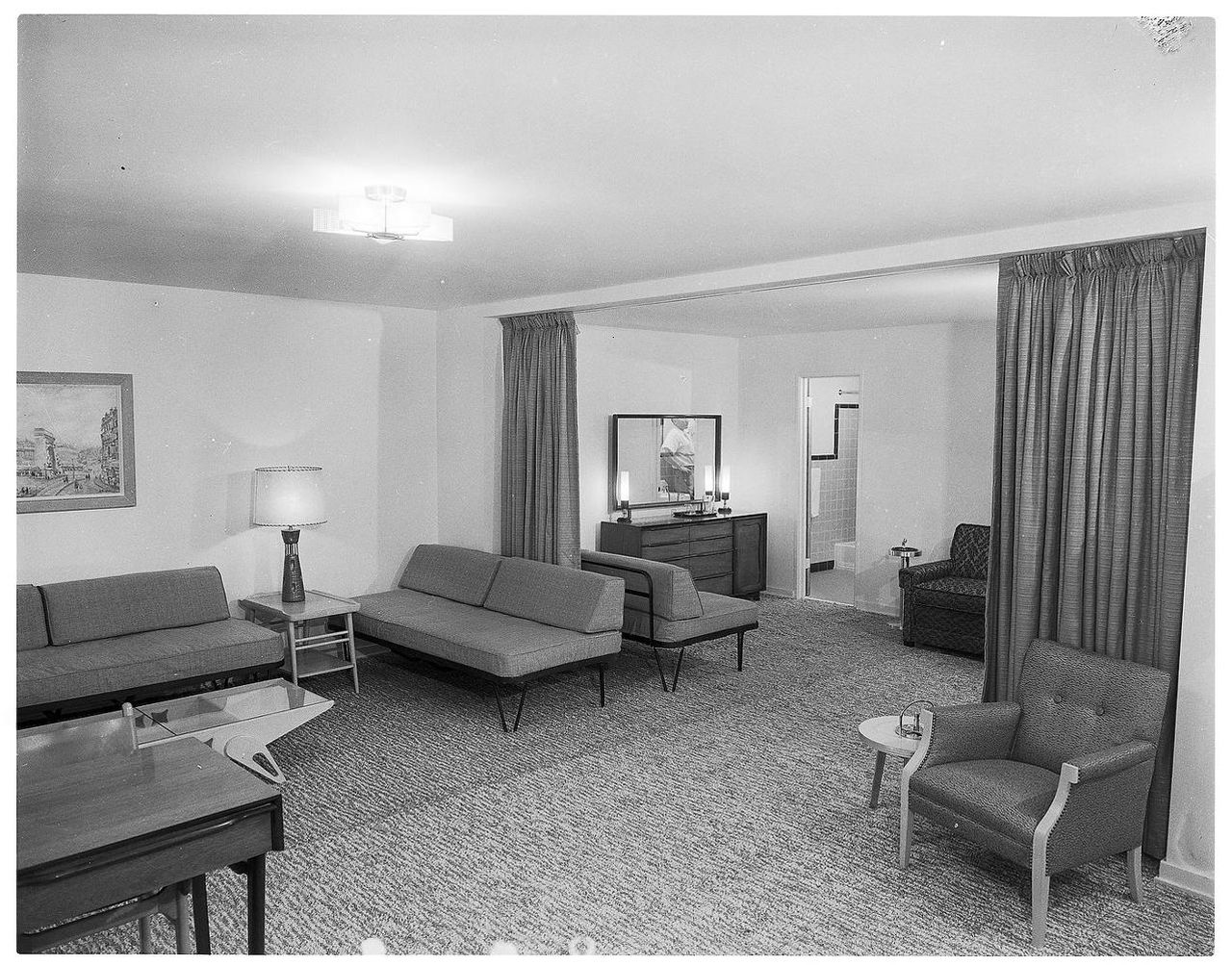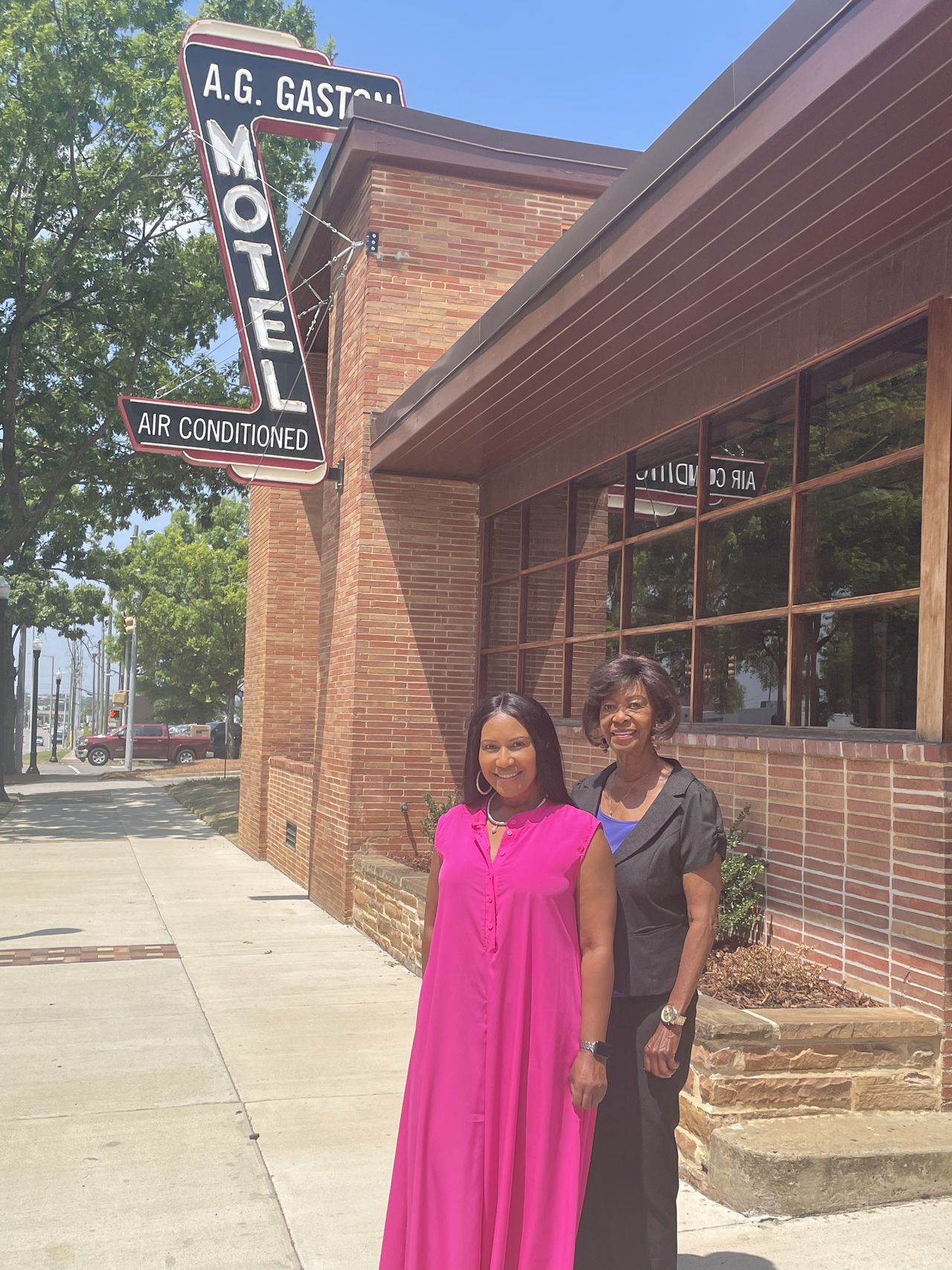Birminghamâs A.G. Gaston Motel to open soon as National Historic Landmark
Creola Gaston Lucas took in every detail, pausing to gaze at the framed magazine articles, images and personal items on display inside the restored motel that bears the name of her grandfather: Birmingham businessman and trailblazing entrepreneur Arthur George “A.G.” Gaston.
As she looked over the historical record of her grandfather’s accomplishments in the gallery dedicated to him, Lucas was instantly reminded of the familiar sweet smell of his tobacco pipe. It took her back to her childhood days.
“It makes me think about times with him,” Lucas said with a smile.
The A.G. Gaston Motel will open to the public this summer as a National Historic Landmark, located on Fifth Avenue North in downtown Birmingham.
After sitting silently and deteriorating for decades, as multiple proposals for restoration fell through, the doors of the historic motel are finally set to reopen in conjunction with the city’s observance of the 60th anniversary of seminal civil rights events of 1963.
Ahead of the opening, Lucas and her niece Rochelle Gaston Malone took a tour to remember and honor the accomplishments of their patriarch. A.G. Gaston, the grandson of formerly enslaved people, was born in abject poverty in Alabama’s Black Belt. Yet he became a pillar of Birmingham business with a portfolio worth millions. He lived to be 103, building an empire that included a funeral home, insurance company, bank and the motel that still bears his name.
Dr. Martin Luther King and Rev. Wyatt Tee Walker announce an agreement with Birmingham businesses to desegregate certain services and jobs in the city. The leaders met with the press inside the courtyard of the A.G. Gaston Motel to make the announcement, May 10, 1963. (Tom Self, The Birmingham News) bn
His family moved from a log cabin in Demopolis to find opportunities in the new and growing city of Birmingham in the early years of the 20th century.
“He left no stone unturned for everything that was needed for the Black community,” Lucas said. “They all were first class. Everything he touched was worthwhile.”
Built in 1954 and expanded in 1968, the Gaston Motel was among few overnight accommodations for Black travelers during the era of strict racial segregation.
The motel was a cornerstone of the civil rights movement in Birmingham, sitting just yards from Kelly Ingram Park and Sixteenth Street Baptist Church. As a result of its prominent place during the movement, the motel was bombed in May 1963.
It is believed that King’s suite was the target of the blast. The Birmingham home of King’s brother, the Rev A.D. King, was also bombed at nearly the same time.
After additional renovations by the National Park Service, visitors to the motel will eventually be able to tour Room 30, known as the “War Room,” where civil rights leaders gathered in the 1960′s to plan a series of demonstrations known as Project C. The campaign was led by civil rights giants, including the Revs. Martin Luther King, Fred Shuttlesworth, Ralph Abernathy and Wyatt Tee Walker.
In addition to its place as a civil rights movement headquarters, the motel was also a center of social life for Black people in Birmingham throughout the 1950s and 1960s. The motel’s supper club hosted performances, civic gatherings and wedding receptions. The motel was also a stop for celebrities, including Aretha Franklin, Duke Ellington, Harry Belafonte and Count Basie.
The outlook for the motel has drastically improved since a decade ago when graffiti across the front entrance represented its most recent paint job in years.
By 2015 the National Trust for Historic Preservation named the motel among America’s 11 most endangered historic places. Plans were floated around that time to preserve and develop the motel as a civil rights museum and education center.
A lasting solution for the motel finally arrived in 2017 when it was included as part of the Birmingham Civil Rights National Monument by President Barack Obama in his final days in office.
The national monument site includes portions of the Birmingham Civil Rights District, including the motel, the Birmingham Civil Rights Institute, Sixteenth Street Baptist Church, Kelly Ingram Park, Bethel Baptist Church in Collegeville and other historic sites.
Obama’s declaration set the stage for the National Park Service to acquire the 1954 wing of the motel with plans for programming in coming years. Restoration began in 2019.
Today, the exterior of the historic site is stabilized and restored to its original appearance. The city of Birmingham committed $10 million to restore a portion of the motel that was added in 1968. The Park Service is restoring and will manage the 1954 portion, including King’s room.
“We’ve been busy for the last four and half years in undertaking the restoration of this motel,” said Denise Gilmore, senior director of the city’s division of social justice and racial equity.
Gilmore said the effort spanned several years and two administrations — current Mayor Randall Woodfin and former mayor William Bell — along with multiple government agencies.
“It truly was a collaborative effort to get what you see today,” she said.
Lucas, in her 2020 memoir recalling experiences with her grandfather, includes a few pages about her times at the motel as a child. She detailed its restaurant, recalling the homemade lemon icebox pies that were served daily.
Lucas named several notable people with ties to the motel, including Colin Powell, who went on to become chairman of the Joint Chiefs of Staff and secretary of state. Powell married Birmingham native Alma Powell and the couple honeymooned at the hotel in 1962.
“Its 32 spectacle guest rooms, with master suites, private baths, telephones, and jukeboxes, record players mounted to the wall in every room, were the first of their kind in Birmingham and the south,” Lucas wrote. “Grandaddy had an open-door policy at the motel, making it a place for guests from many states as well as foreign countries. The A.G. Gaston Motel was listed in the Green Book, a guidebook for African American road trippers informing them of places that accepted African American travelers.”

FILE – 1954 file photos of the newly opened A.G. Gaston Motel in Birmingham, Alabama. The motel would become famous as a meeting place for Dr. Martin Luther King and other civil rights era leaders. (FILE-The Birmingham News) 54-5022 A.G. Gastons New Motel Ext and Sign Bham Motels 4×5
A $1.1 million grant from the Mellon Foundation funded the A.G. Gaston exhibit. The display also includes items from Gaston’s family and close associates.
As she toured the site, Lucas expressed optimism that the display would grow over time to examine more of Gaston’s family life.
City officials explained that the motel is an evolving project. For example, the portion of the site owned by the National Parks Service will eventually include a restored Room 30 to show what it looked like during King’s stays there. Some other rooms will also be restored for public viewing.
On the city side, Gilmore said additions could be made to the exhibit, along with the opening of a coffee shop. After the tour with Lucas, Gilmore also proposed expanding a current video presentation on Gaston to include Lucas and her recitation of a poem that she wrote to honor her grandfather.
“What we hope to do over time is look at how we can once again create some community gathering space which is what the motel was,” she explained. “We will look at how we can make more of the motel accessible for public use.”
For now, though, city officials said the mission is getting the motel ready for a public opening day as soon as possible.
As a child, Lucas said, she did not understand that her grandfather was rich until others told her. His shiny Cadillac, tailored suits, or even the hotel bearing his name didn’t seem unusual to the young child who was used to seeing her grandfather surrounded by the elements of his success.
“He was very humble,” Lucas said. “I never saw my grandfather brag about anything.”
To many, A.G. Gaston was a business, civic and cultural icon. But as they toured the motel, Lucas and Malone remembered him simply as “Granddaddy.”
“He would leave his office and walk down Third Avenue North greeting everybody. Everybody knew who Dr. Gaston was,” recalled Lucas, a daughter of Gaston’s only child, A.G. Gaston Jr.
Lucas described Gaston as a loving grandfather. He wasn’t the type to give you rides on his back yet was more subtle with affectionate pats on the head, Lucas said.
“He was laid back. He would listen a lot and teach a lot,” she said.
And the man known as a business magnate also enjoyed subtle pleasures including times at home where he fired the barbecue grill. His other guilty pleasure was Chinese food, Lucas said with a smile.

Creola Gaston Lucas and Rochelle Gaston Malone, the granddaughter and great-granddaughter of A.G. Gaston, tour an exhibit dedicated to their patriarch ahead of the motel’s public opening. (Photo, City of Birmingham)
Marie Sutton, Birmingham’s public information officer, also detailed the motel’s history in her 2014 book, “The A.G. Gaston Motel in Birmingham: A Civil Rights Landmark.”
“This place was a part of not just civil rights history, but the history of the people who lived here in Birmingham,” Sutton said. “To see this place that was once bustling and hustling to get new life, it just takes my breath away.”
While researching her book, Sutton was surprised to discover own personal connection to the motel. Her parents held their wedding reception there.
“I am so excited and look forward to new history being made at the A.G. Gaston Motel,” Sutton said.
For Malone, the new exhibit offers an opportunity for current and future generations to learn about her great-grandfather, and more importantly, to find inspiration from his life story.
“It is an important piece of history that our young people need to experience,” Malone said, as she sat next to a glass display case in the gallery. “They need to know the human behind the name. They need to learn the intimate parts of him. A piece of this exhibit, I hope, will inspire, impress, and engage them to create the motivation for them to forge forward in their dreams. That’s what the exhibit means and that’s my desire for it.”
